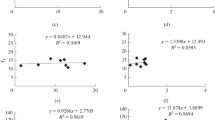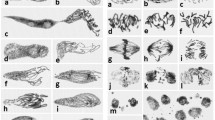Abstract
The rate of DNA synthesis in the course of the division cycle in root meristem ofAllium cepa growing under constant temperature and aeration conditions has been studied by means of treatment with AdR, as a specific inhibitor of the synthesis, as well as by the incorporation of tritiated thymidine. The one-hour treatment with AdR or tritiated thymidine was given at various hours in the course of the interphase of a synchronous population of binucleate cells induced by caffeine. In the case of AdR, sensitivity to the inhibition of DNA synthesis was studied by recording the delays produced by the treatment in the appearance of biprophases and bitelophases. The selection by the use of caffeine, of spontaneously synchronous populations of cells going through the telophase and becoming binucleate and the detection of the first biprophases in the subsequent mitosis provide a highly synchronized system with which to study the incorporation of tritiated thymidine during the interphase. The curves representing sensitivity to the inhibition of DNA synthesis by AdR and the rate of tritiated thymidine incorporation coincide, so that we can regard the delays, under our conditions, as proportional to the rate of DNA synthesis at the moment of the AdR treatment. This rate, in the S period, was found to be variable by both methods, being higher in the first and the last thirds of the S period (S1 and S3) and lower in the middle third (S2).
Similar content being viewed by others
References
Brown, S. W.: Heterochromatin. Science151, 417–425 (1966).
Cleaver, J. E.: Thymidine metabolism and cells kinetics, p. 259. Amsterdam: North-Holland Publishing Company 1967.
Conger, A. D., Fairchild, L. M.: A quick-freeze method for making smear slides permanent. Stain Technol.28, 281–283 (1953).
Pernández-Gómez, M. E.: Rate of DNA synthesis in binucleate cells. Histochemie12, 302–306 (1968).
- González-Fernández, A., Giménez-Martin, G., López-Sáez, J. P.: Interphase sensitivity to inhibition of DNA synthesis. Mutation Res. (In the press 1969).
Giménez-Martin, G., González-Fernández, A., Lopez-Sáez, J. F.: A new method of labelling cells. J. Cell Biol.26, 305–309 (1965).
González-Fernández, A., Fox, D. F., Evans, H. J.: DNA replication in binucleate cells ofAllium cepa. (In preparation).
Howard, A., Dewey, D. L.: Non-uniformity of labelling rate during DNA synthesis. Exp. Cell Res.24, 623–624 (1961).
—, Pelc, S. R.: Synthesis of deoxyribonucleic acid in Normal and irradiated cells and its relation to chromosome breakage. Heredity, Suppl.6, 261–273 (1953).
Jensen, W. A.: The nucleic acid and protein content of root tip cells ofVicia faba andAllium cepa. Exp. Cell Res.14, 675–583 (1968).
Kasten, F. H., Strasser, F. F.: Nucleic acid synthetic patterns in synchronized mammalian cells. Nature (Lond.)211, 135–140 (1966).
Kihlman, B. A.: Deoxyadenosine as an inducer of chromosomal aberrations inVicia faba. J. cell. comp. Physiol.62, 267–272 (1963).
—: Deoxyribonucleotide synthesis and chromosome breakage. In: Chromosomes today, vol. 1 (C. D. Darlington, and K. R. Lewis, eds.), p. 108–117. Edinburgh: Oliver and Boyd 1966.
—, Hartley, B.: Interphase sensitivity to the chromosome-breaking effect of 2-deoxyadenosine: an autoradiographic study. Mutation Res.4, 771–782 (1967).
—, Nichols, W. W., Levan, A.: The effect of deoxyadenosine and cytosine arabinoside on the chromosomes of human leukocytes in vitro. Hereditas (Lund)50, 139–143 (1963).
—, Odmark, G.: Effects of adenosine nucleosides on chromosomes, cell division and nucleic acid synthesis inVicia faba. Hereditas (Lund)56, 71–82 (1966).
Klenov, H.: On the effect of some adenine derivatives on the incorporation in vitro of isotopically labelled compounds into the nucleic acids of Ehrlich ascites tumor cells. Biochim. biophys. Acta (Amst.)35, 412–421 (1959).
—: Further studies on the effect of deoxyadenosine triphosphate and inhibition of deoxyribonucleic acid synthesis in Ehrlich ascites tumor cells in vitro. Biochim. biophys. Acta (Amst.)61, 885–896 (1962).
López-Sáez, J. P., Giménez-Martin, G., González-Fernández, A.: Duration of the cell division cycle and its dependence on temperature. Z. Zellforsch.75, 591–600 (1966).
Maley, G. F., Maley, P.: Inhibition of deoxyribonucleic acid synthesis in chick embryos by deoxyadenosine. J. biol. Chem.235, 2964–2967 (1960).
McDonald, B. B.: Synthesis of deoxyribonucleic acid by micro and macronuclei ofTetrahymena pyriformis. J. Cell Biol.13, 193–203 (1962).
Miller, O. L., Stone, G. E., Prescott, D. M.: Autoradiography of soluble materials. J. Cell Biol.23, 654–658 (1964).
Munch-Petersen, A.: Formation in vitro of deoxyadenosine triphosphate from deoxyadenosine in Ehrlich ascites cells. Biochem. biophys. Res. Commun.3, 399–396 (1960).
Newton, A. A., Wildy, P.: Parasynchronous division of HeLa cells. Exp. Cell Res.16, 624–635 (1959).
Odmark, G., Kihlman, B. A.: Effects of chromosome-braking purine derivatives on nucleic acid synthesis and on the levels of adenosine-5-triphosphate and deoxyadenosine-5-triphosphate in bean root tips. Mutation Res.2, 274–286 (1965).
Painter, R. B., Drew, R. M., Giauque, B. G.: Further studies on deoxyribonucleic acid metabolism in mammalian cell cultures. Exp. Cell Res.21, 98–105 (1960).
Pelc, S. R.: Incorporation of labelled precursors of DNA in non-dividing cells. In: Cell proliferation (L. P. Lamerton and R. J. M. Fry, eds.), p. 94–109. Oxford: Blackwell 1963.
Prusoff, W. H.: Further studies on the inhibition of nucleic acid biosynthesis by azathimidine and by deoxyadenosine. Biochem. Pharmacol.2, 221–225 (1959).
Reichard, P., Canellakis, Z. N., Canellakis, E. S.: Studies on a mechanism for the biosynthesis of deoxyribonucleic acid. J. Biol. Chem.236, 2514–2619 (1961).
Stone, G. E., Miller, O. L., Prescott, D. M.: H3-thymidine derivative pools in relation to macronuclear DNA synthesis inTetrahymena pyriformis. J. Cell Biol.25, 171–177 (1965).
Tjio, J., Levan, A.: The use of oxiquinoline in chromosome analysis. An. Estac. Exp. Aula Dei.2, 21–64 (1951).
Van't Hof, J.: Relationship between mitotic cycle duration, S period duration and the average rate of DNA synthesis in the root meristem cells of several plants. Exp. Cell Res.39, 48–58 (1965).
Author information
Authors and Affiliations
Rights and permissions
About this article
Cite this article
Fernández-Gómez, M.E., Stockert, J.C., González-Fernández, A. et al. Delays in prophase induced by adenosine 2-deoxyriboside and their relation with DNA synthesis. Chromosoma 29, 1–11 (1970). https://doi.org/10.1007/BF01183657
Received:
Accepted:
Issue Date:
DOI: https://doi.org/10.1007/BF01183657




